The Cultural Significance of Headwraps & How to Wear Them: Embracing Heritage and Style
Danny Duod on 7th May 2025
Headwraps have adorned the heads of people across various cultures for centuries, serving as powerful symbols of heritage, identity and spirituality. From African traditions to South Asian customs, these fabric crowns tell stories of resistance, celebration and cultural pride.
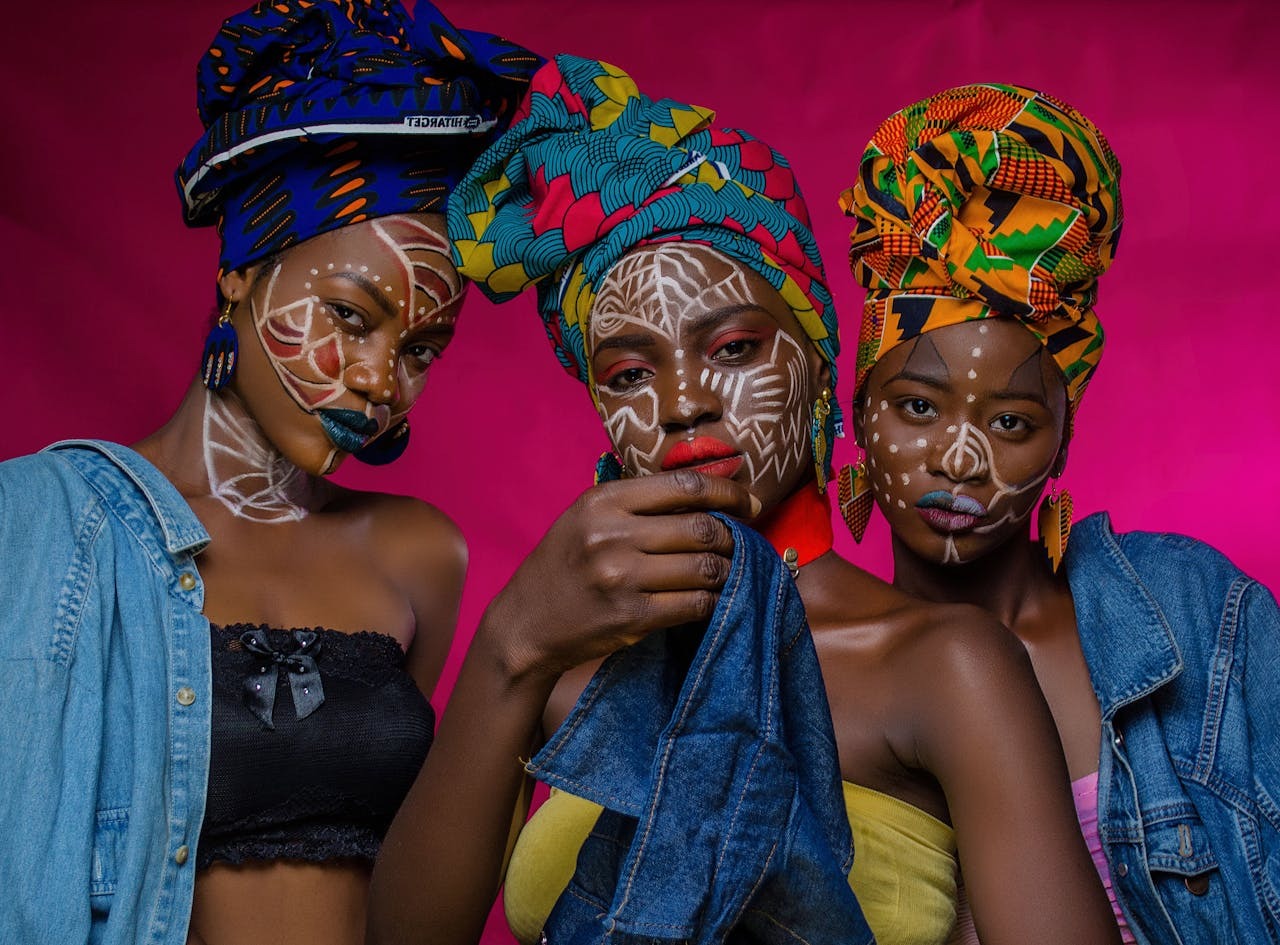
Headwraps represent more than just fashion—they embody historical resilience and contemporary self-expression. Throughout history, communities have used these versatile textiles to signify social status, religious devotion or cultural belonging. In many African societies, the specific wrapping style might indicate a person's marital status, whilst in other communities, headwraps served as silent forms of resistance during times of oppression.
Today, people worldwide embrace headwraps as a meaningful way to honour their roots or appreciate cultural artistry. The beauty of headwraps lies in their accessibility—with just a piece of fabric and some basic techniques, anyone can participate in this rich tradition whilst respecting its origins and significance.
Origins And Historical Importance
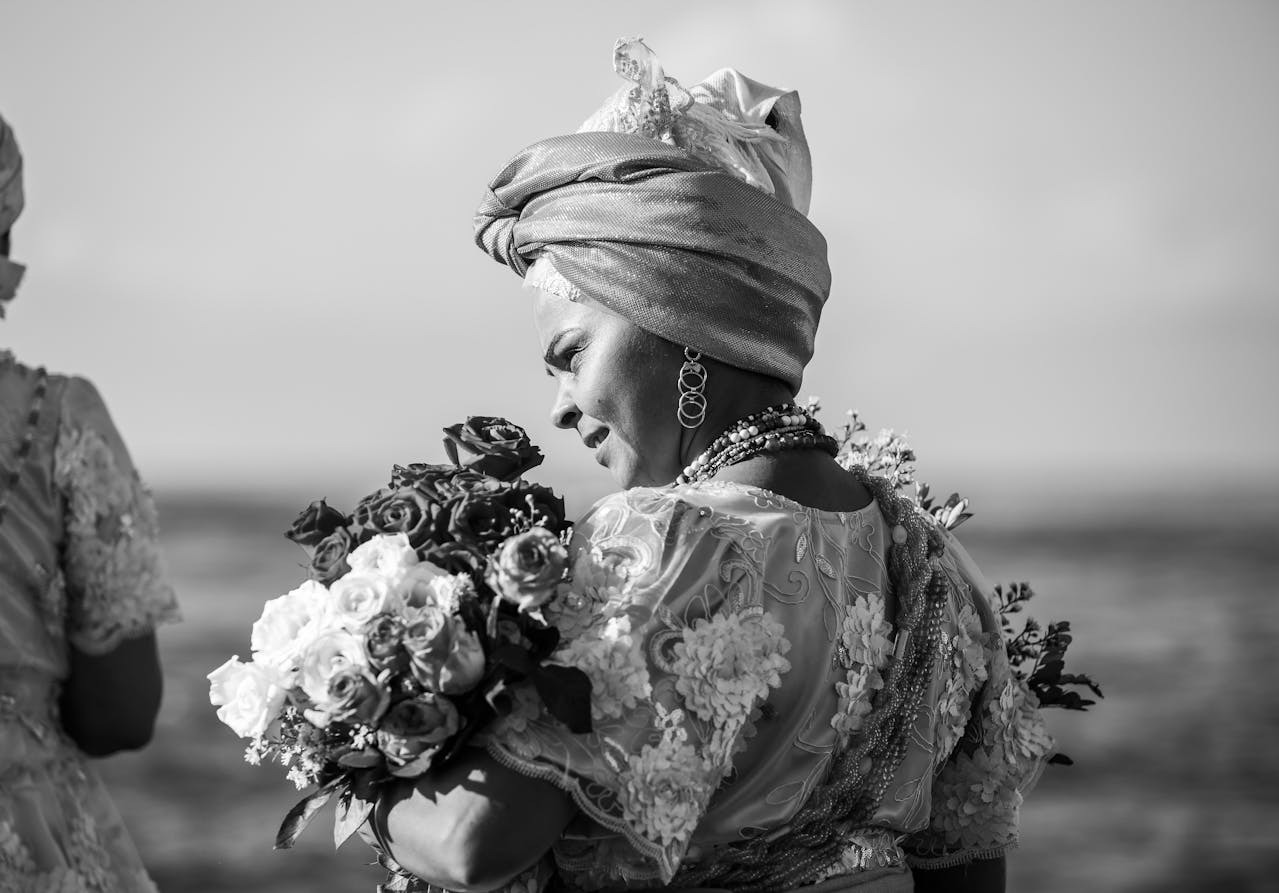
Headwraps have deep roots in human history, serving practical, cultural, and spiritual purposes across diverse civilisations for thousands of years. Their evolution reflects complex social histories and continues to influence contemporary fashion.
Traditional Cultures And Early Use
Headwraps originated in ancient African, Middle Eastern, and Asian societies as early as 3000 BCE. Initially, they served practical purposes—protecting against harsh sun, dust, and wind in arid climates. Egyptian hieroglyphs depict nobility wearing elaborate head coverings, suggesting early social significance.
In West Africa, archaeological evidence reveals headwrap traditions dating back to the Kingdom of Ghana (300-1200 CE). These early wraps were crafted from locally woven textiles with region-specific patterns.
Indigenous communities in South America and India independently developed similar head covering practices. The Maya used cotton headwraps as status indicators, with intricate wrapping techniques signifying one's social position.
Symbolism In African Societies
In many African cultures, headwraps (known as gele in Nigeria, duku in Ghana, and dhuku in Zimbabwe) conveyed distinct social messages. The specific folding, material, and design often indicated:
- Marital status
- Age and social position
- Religious affiliation
- Ethnic identity
During colonial oppression, headwraps became symbols of resistance and cultural preservation. In South Africa, the doek represented dignity during apartheid when Black women were forced into domestic service.
The Yoruba people view the gele as a crown—its height and elaborateness reflecting the wearer's status. For celebrations, special wrapping styles create dramatic, sculptural forms that demonstrate the wearer's creativity and cultural pride.
Influence On Global Fashion
Headwraps entered global fashion consciousness through complex historical pathways, often tied to migration and cultural exchange. During the transatlantic slave trade, enslaved African women maintained headwrap traditions despite brutal attempts to erase their cultural practices.
In the 1940s, American factory workers adopted functional "Rosie the Riveter" headscarves. By the 1960s, civil rights and Black Pride movements reclaimed headwraps as powerful symbols of African heritage and resistance.
Contemporary designers like Stella Jean and Ozwald Boateng regularly incorporate traditional headwrap elements into high fashion. Celebrities such as Lupita Nyong'o and Zadie Smith have showcased elegant headwraps on red carpets and magazine covers.
Key headwrap influences in modern fashion:
- The resurgence of African wax prints
- Sustainable fashion movements embracing traditional textiles
- Social media platforms showcasing diverse wrapping techniques
Cultural Symbolism And Meanings
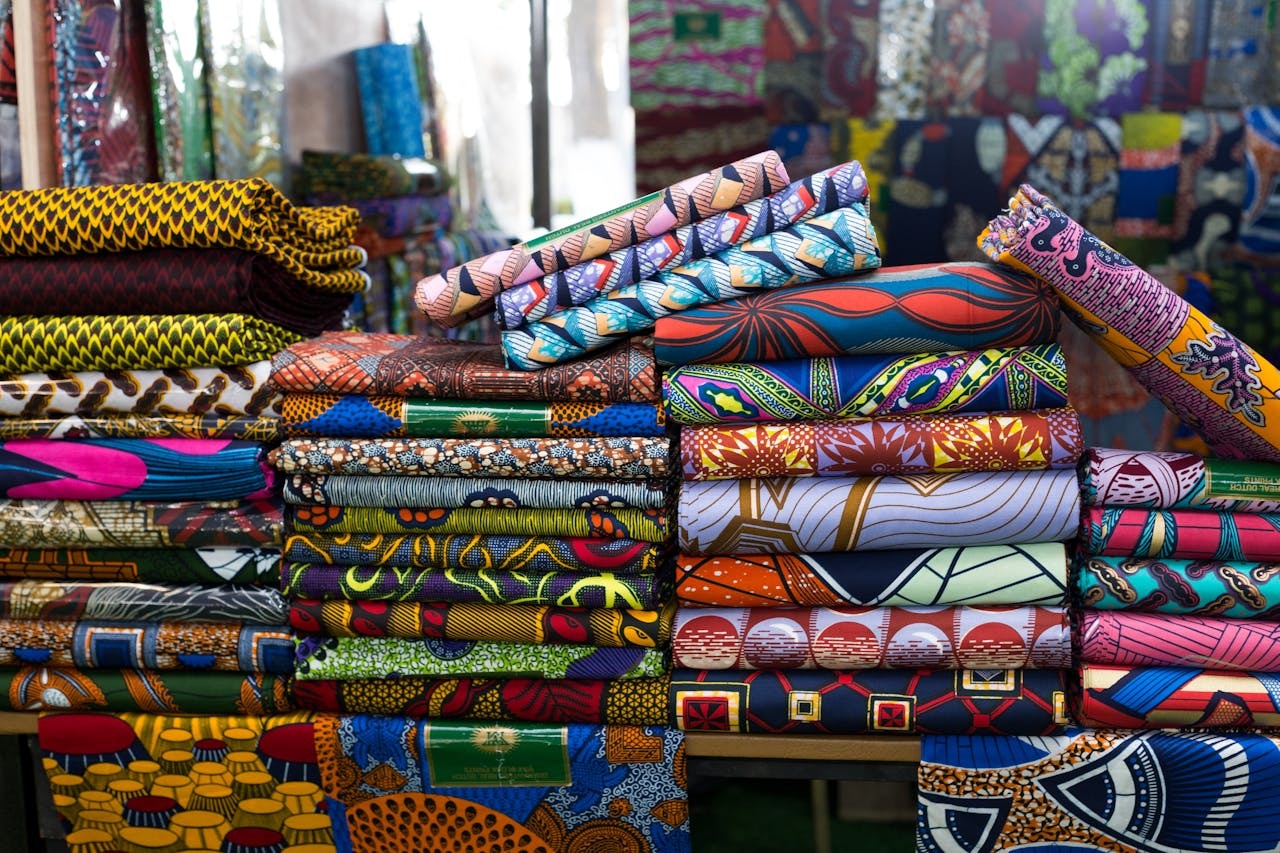
Headwraps carry deep cultural meanings that vary significantly across different societies and historical contexts. The fabric, colours, patterns, and wrapping techniques often communicate important social messages about the wearer.
Status And Identity
Headwraps have historically functioned as visual indicators of social status and identity in many cultures. In parts of West Africa, the Gele (elaborate headwraps) signal a woman's marital status, age, and sometimes wealth. The size, material, and complexity of the wrap often correlate with the wearer's social position.
In South Africa, the Doek represents cultural pride and womanhood. Different communities may use specific colours or patterns to identify tribal affiliations or family lineage.
Caribbean headwraps evolved from African traditions but developed unique meanings. The Tignon laws of 18th-century Louisiana forced Black women to cover their hair, yet women transformed these wraps into fashion statements of resistance and beauty.
Today, headwraps continue to serve as powerful symbols of cultural identity and heritage for diaspora communities, particularly for Black women reconnecting with ancestral traditions.
Religious And Spiritual Connections
Headwraps hold significant religious meaning across various faith traditions. In many Islamic communities, women wear hijabs not only for modesty but as expressions of faith and devotion. The style and fabric may vary by region but share a common spiritual purpose.
Sikh turbans (dastar) represent equality, honour, and self-respect. The careful wrapping process itself is considered a spiritual practice.
In some African spiritual traditions, headwraps can serve protective functions. White wraps often symbolise purity and connection with ancestors during religious ceremonies.
Orthodox Jewish women's tichels and Christian Orthodox head coverings similarly reflect religious observance and modesty. The wrapping techniques and materials may carry additional meanings related to the wearer's marital status or community.
These coverings transcend mere fabric to become powerful expressions of faith, creating visible connections between the wearer and their spiritual beliefs.
Headwraps In Ceremonial Events
Headwraps feature prominently in life celebrations and ceremonial gatherings worldwide. At Nigerian weddings, the bride and female guests often wear elaborately tied geles that complement their outfits, with certain colours and fabrics reserved for specific roles in the ceremony.
In Jamaican traditions, white headwraps may be worn during birth ceremonies or funerals, marking transitions between life stages. The colour white represents purity and spiritual connection.
During coming-of-age celebrations in many cultures, the first wearing of a headwrap can symbolise the transition to adulthood. The wrapping itself may be performed as a ritual, with elder women passing down techniques and knowledge.
Modern cultural festivals increasingly feature headwrap workshops and competitions, keeping these traditions alive while celebrating their beauty and significance. The style and fabric choices often reflect both traditional meanings and contemporary fashion sensibilities.
Regional Styles And Variations
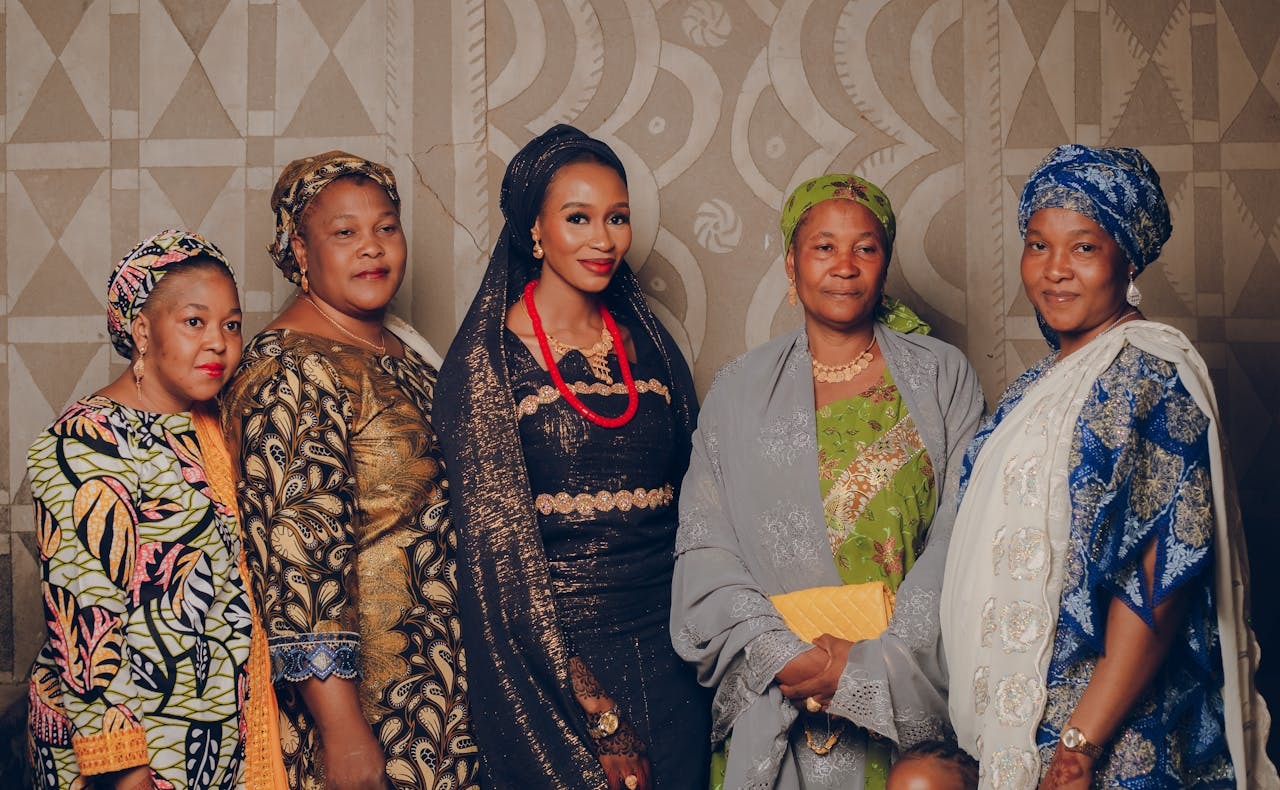
Headwraps vary dramatically across cultures and regions, each with unique folding techniques, fabric choices, and cultural meanings. These differences reflect local histories, climate adaptations, and artistic expressions that have evolved over centuries.
African Headwrap Traditions
The gele from Nigeria stands out as perhaps the most recognisable African headwrap style. Worn by Yoruba women, these elaborate structures often fan outward with stiff, structured folds that require considerable skill to create. In contrast, Ghanaian duku styles typically wrap more closely to the head in circular formations.
Malian headwraps often feature indigo-dyed cotton with distinctive patterns. Women in Mali wrap their cloth in ways that display marital status and social position.
East African styles like those in Ethiopia and Eritrea tend to incorporate lighter fabrics with delicate embroidery. The shash headwrap in Sudan features draping fabric that protects from harsh sun and sandstorms.
Regional Fabric Preferences:
- West Africa: Vibrant wax prints and kente
- North Africa: Lighter, sometimes sheer materials
- East Africa: Cotton with intricate embellishments
Caribbean Headwrap Interpretations
Caribbean headwraps evolved from African traditions but developed distinctive characteristics through colonial influence and necessity. In Jamaica, the tying of the headwrap called "tie-head" indicates one's social status and daily activities.
Trinidadian styles often feature bright colours and incorporate multiple layers or ties. These wraps might be worn higher on the crown with decorative knots at the front.
Cuban turbantes reflect both African and Spanish influences, often featuring larger front knots and colourful patterns. Many Caribbean styles allow for more fabric to flow freely at the back or sides.
The headwraps in Haiti, known as "tèt mare", hold spiritual significance in Vodou traditions. Colours may represent different lwa (spirits) and ceremonial purposes.
During labour-intensive plantation work, practical wraps evolved to keep hair protected whilst working in humid conditions.
Headwraps In Diaspora Communities
Black British women have embraced headwraps as symbols of cultural pride and connection to heritage. Urban styles often blend traditional techniques with contemporary fabrics and accessories like statement earrings or pins.
African American headwrap traditions developed distinctively through the painful history of slavery and subsequent identity reclamation. The tignon laws of Louisiana once forced Black women to cover their hair—a restriction they transformed into artistic expression.
Modern diaspora interpretations frequently incorporate sustainable materials and ethical sourcing. Many young wrappers experiment with fabrics beyond traditional choices, using denim, upcycled materials, or luxury silks.
Social media has created a renaissance of headwrap wearing, with tutorial videos teaching techniques from numerous cultural traditions. Many wearers now mix elements from different regions to create personalised styles that honour multiple aspects of their heritage.
Materials And Fabrics Used
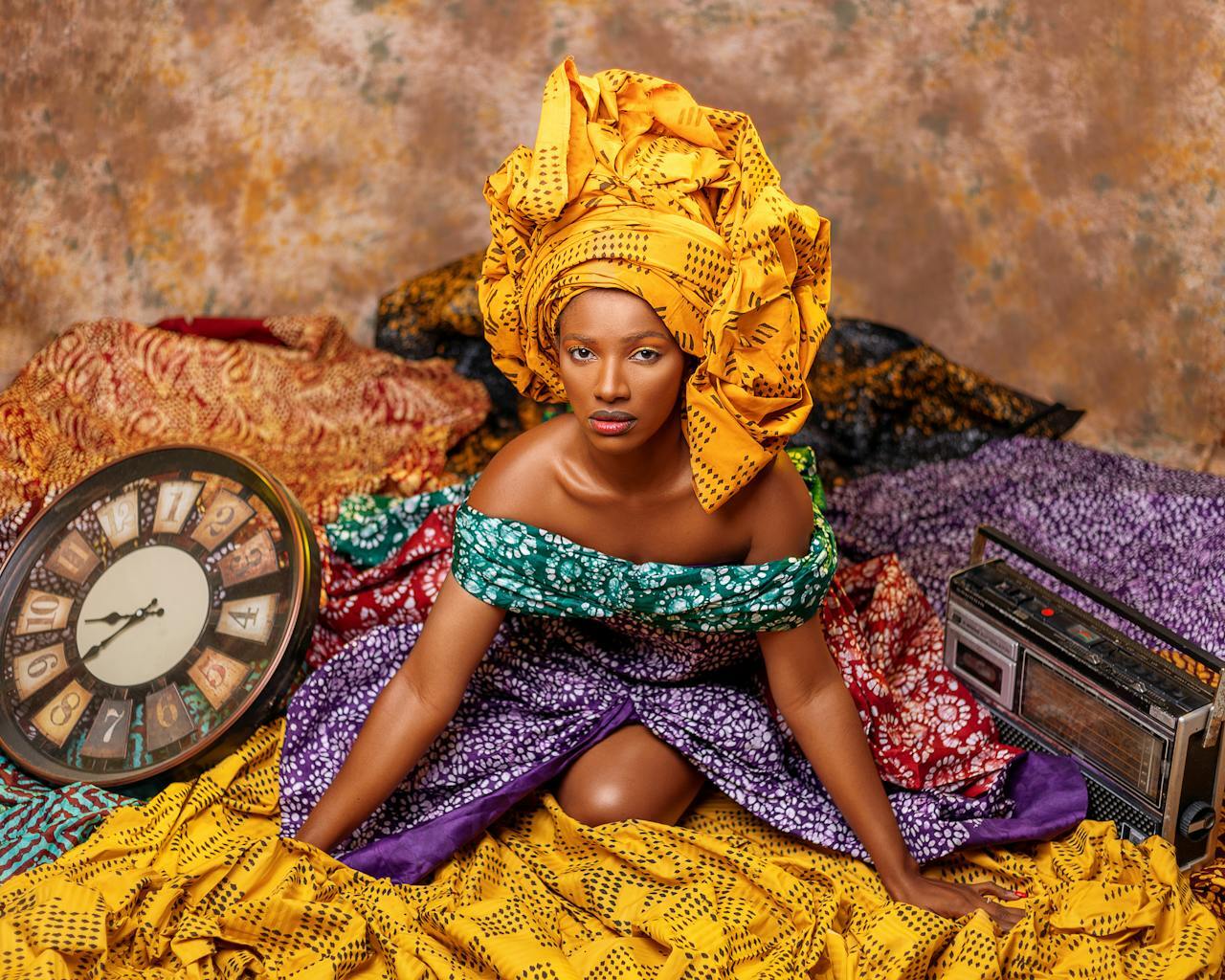
Headwraps utilise diverse fabrics, each with unique properties that affect appearance, function and comfort. The right material choice depends on climate, occasion and personal style preferences.
Natural Fibres And Textiles
Cotton remains the most popular fabric for headwraps due to its breathability and comfort. This natural fibre absorbs moisture well, making it ideal for daily wear and warmer climates.
Linen headwraps offer exceptional coolness and lightweight feel, perfect for summer months. Though they wrinkle easily, many consider this part of linen's distinctive charm.
Silk provides a luxurious option with its smooth texture and elegant sheen. Whilst more expensive, silk headwraps are often reserved for special occasions and formal events.
Wool and wool blends serve well in colder environments, providing warmth and natural water resistance. These textiles often feature in winter headwrap collections.
Common Natural Headwrap Fabrics:
- Cotton: Breathable, versatile, affordable
- Linen: Cooling, lightweight, casual
- Silk: Luxurious, smooth, formal
- Wool: Warm, insulating, structured
Patterns And Colours
Traditional African headwrap patterns often feature bold geometric designs and vibrant colour combinations. Ankara prints display distinctive wax-resist dyeing techniques with symbolic meanings embedded in their patterns.
Kente cloth, originating from Ghana, incorporates intricate weaving patterns with colours that carry specific cultural significance. Yellow symbolises fertility, blue represents peace, and red signifies spiritual energy.
Solid colours offer versatility and simplicity. Deep jewel tones like emerald green and sapphire blue complement many skin tones, whilst neutral shades provide everyday practicality.
Modern headwraps often blend traditional and contemporary designs. Ombré effects, subtle metallic threads and hand-painted motifs have gained popularity in recent years.
The colour and pattern choice may reflect:
- Cultural heritage
- Personal style
- Seasonal trends
- The specific occasion
Modern Relevance And Social Impact
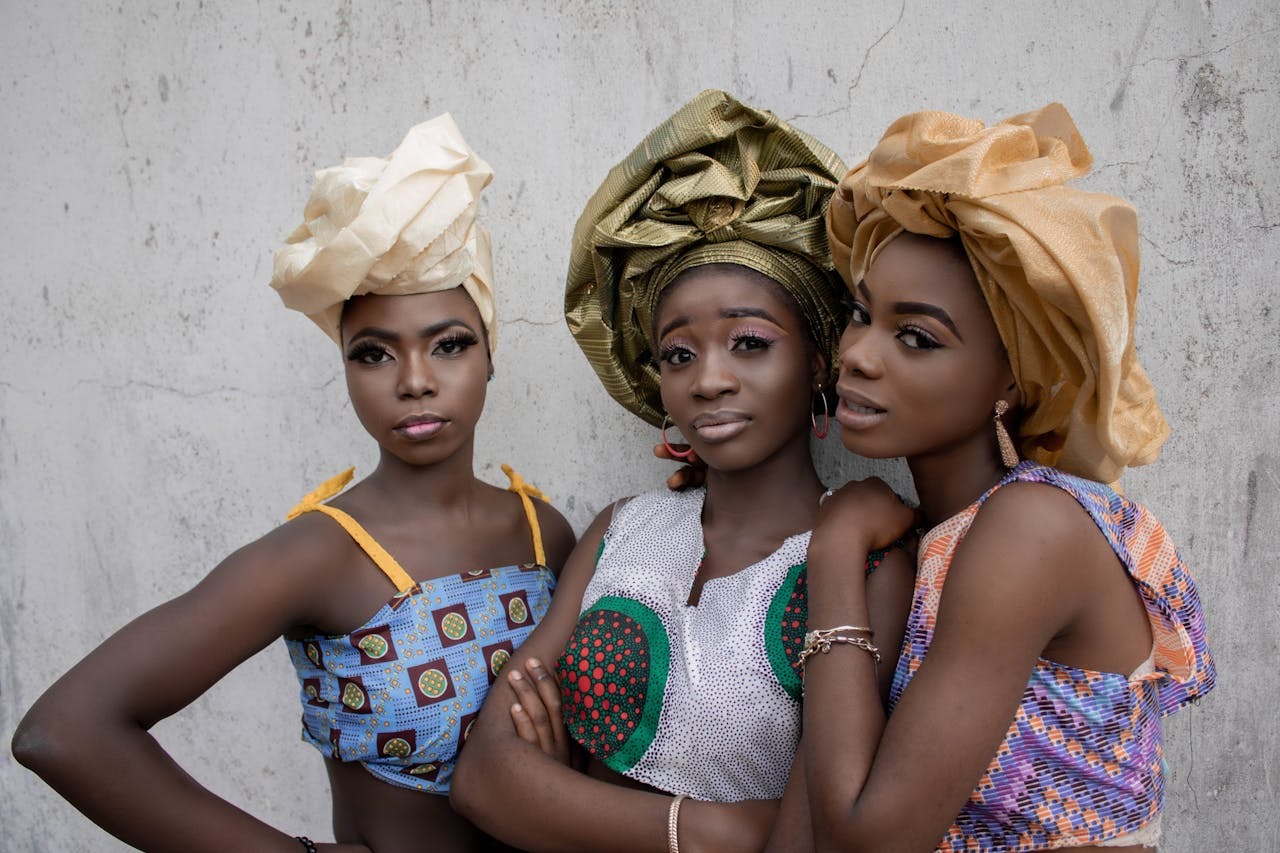
Headwraps continue to evolve as powerful symbols of cultural identity and personal expression in contemporary society. Their significance extends beyond fashion into realms of political statement, cultural preservation and social commentary.
Empowerment And Identity Today
Headwraps have experienced a significant resurgence as tools of empowerment and self-expression. Many individuals wear them to reconnect with their heritage and celebrate their cultural roots in increasingly diverse societies.
For Black women particularly, headwraps represent reclamation of identity and beauty standards outside Eurocentric norms. They serve as visible rejection of historical oppression and contemporary marginalisation.
In professional settings, headwraps challenge conventional dress codes whilst asserting one's right to cultural expression. Many workplaces now recognise them as important cultural and religious attire deserving accommodation.
Fashion designers incorporate headwrap-inspired elements into mainstream collections, though this sometimes raises valid concerns about cultural appropriation versus appreciation. The distinction hinges on respect, acknowledgement and understanding of historical context.
Representation In Media
Media portrayal of headwraps has evolved significantly in recent years. Films like Black Panther featured prominent characters wearing elaborate headwraps, celebrating African aesthetics on a global platform.
Social media has democratised representation, with influencers and everyday people showcasing diverse styling techniques and cultural meanings. Platforms like Instagram and TikTok feature countless tutorials celebrating this tradition.
Fashion magazines increasingly include models wearing headwraps, though true diversity remains a work in progress. Independent publications often lead the way in authentic representation.
Music videos and album artwork frequently showcase artists in stunning headwrap styles, connecting contemporary expression with historical traditions. These visual choices often make powerful statements about identity and heritage.
Advertising campaigns have begun including headwraps, though critics note this inclusion must extend beyond tokenism to meaningful representation.
How To Choose A Headwrap
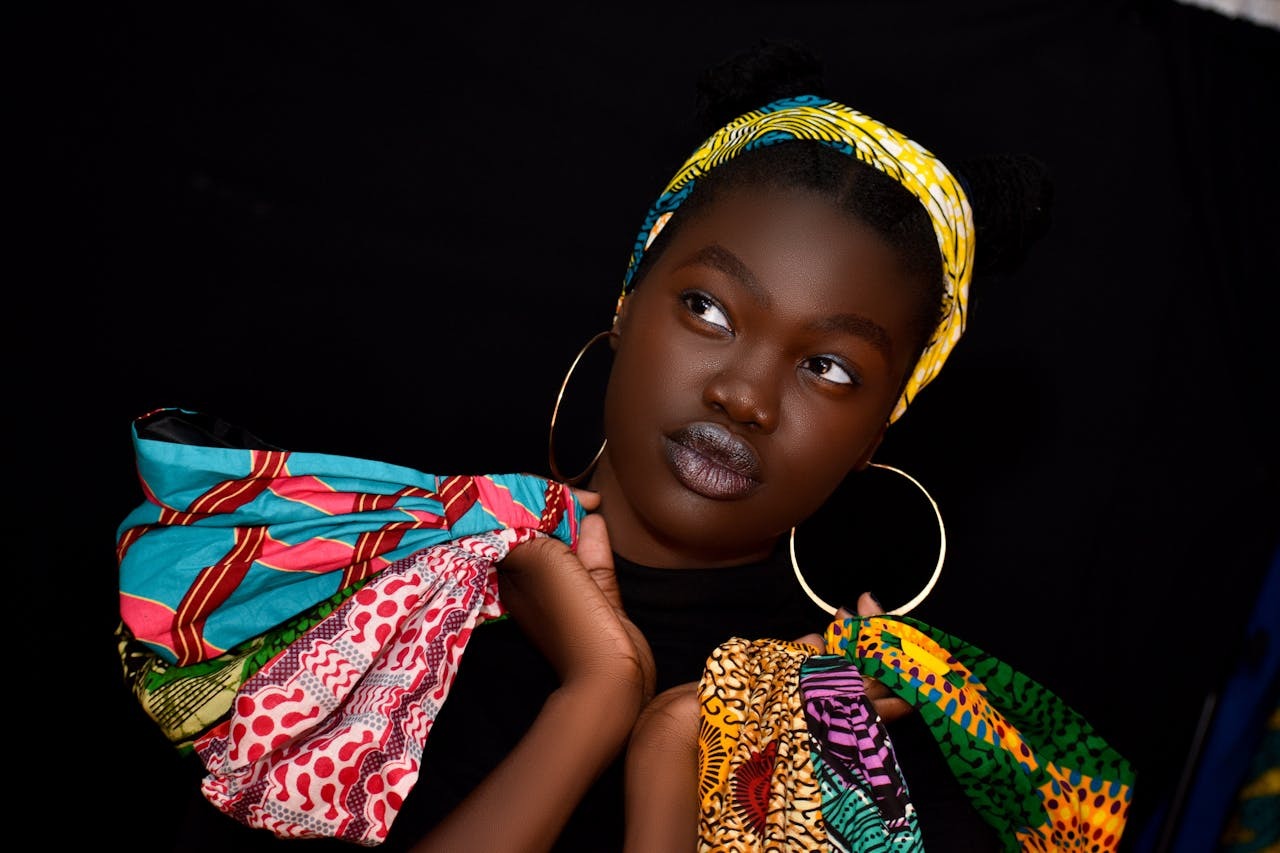
Selecting the perfect headwrap involves considering both practical elements and personal style preferences. The fabric, pattern, size and shape all contribute to both comfort and appearance.
Selecting Fabrics And Patterns
Cotton headwraps offer breathability and comfort for everyday wear, whilst silk and satin options reduce friction on hair and are ideal for overnight protection. Ankara prints showcase vibrant African-inspired patterns that make bold fashion statements.
Consider the season when choosing fabrics. Lightweight cottons and linens work well in summer, while thicker materials like jersey provide warmth during colder months.
Patterns should complement your personal style and wardrobe. Geometric designs offer contemporary appeal, whilst floral prints create a softer look. Solid colours provide versatility for mixing and matching with different outfits.
For beginners, medium-weight cotton with a bit of stretch tends to be easiest to manipulate when learning wrapping techniques. More experienced wearers might experiment with stiffer fabrics that hold elaborate styles better.
Finding The Right Size And Shape
Standard rectangular headwraps typically measure about 60 x 180 cm, providing enough fabric for most traditional styles. Square options (around 100 x 100 cm) offer versatility for different tying methods.
For shorter styles like simple turbans, smaller pieces around 50 x 150 cm may suffice. Those seeking elaborate, statement wraps might prefer longer lengths of 200+ cm.
Consider your head size when selecting a wrap. Most are one-size-fits-all, but those with particularly small or large heads might need custom dimensions.
Pre-shaped options like pre-tied turbans and stretchy tubes are available for beginners or those seeking convenience. These provide the look without requiring wrapping skills.
The right shape depends on your desired style. Rectangular wraps work well for most traditional African and Caribbean styles, whilst triangular shapes suit head tie styles common in West African traditions.
Techniques For Wearing Headwraps
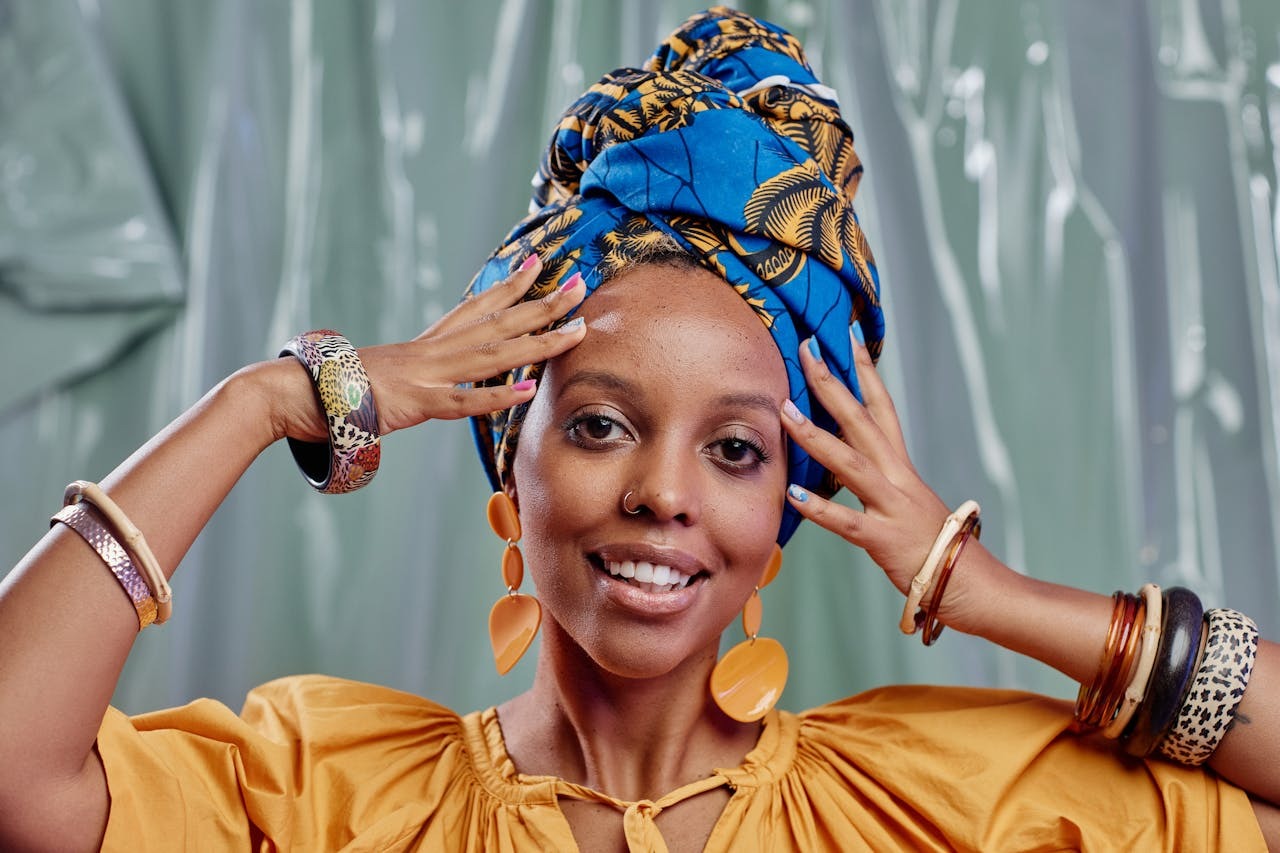
Mastering headwrap techniques requires understanding basic wrapping methods, following step-by-step approaches, and ensuring proper comfort throughout wear. These skills help create stylish looks while honouring the cultural significance of this versatile accessory.
Classic Wrapping Methods
Several traditional methods form the foundation of headwrap styling. The Turban Wrap involves crossing fabric at the nape of the neck and twisting before bringing ends forward to tuck. This creates a full, rounded appearance at the crown.
The Front Knot technique places the knot centrally on the forehead, creating a statement look often seen in West African styling. It begins with fabric centred at the nape and ends tied at the front.
For the Side Wrap, the fabric is twisted asymmetrically with volume concentrated on one side. This method works brilliantly with both plain and patterned fabrics.
The Crown Wrap creates height by building vertical structure above the head. This regal style requires proper fabric stiffness to maintain its shape throughout the day.
Step-By-Step Styling Guide
Begin with a rectangular piece of fabric approximately 1.5-2 metres long. Cotton or lightweight woven materials work best for beginners.
-
Preparation:
- Fold fabric in half lengthwise if very wide
- Position centre of fabric at nape of neck
- Hold both ends with equal length in each hand
-
Basic Wrap Technique:
- Cross ends at forehead
- Pull firmly for tension
- Twist ends together once
- Bring twisted section towards back of head
-
Securing the Wrap:
- Tuck ends under wrapped sections
- Use hairpins at strategic points if needed
- Adjust for desired height and fullness
For beginners, practise in front of a mirror until movements become fluid. Shape can be adjusted by gently pulling fabric to create volume where desired.
Ensuring Comfort And Fit
A comfortable headwrap starts with selecting the right fabric. Cotton and jersey materials offer breathability for everyday wear, while silk creates elegant looks for special occasions but may slip more easily.
Always ensure the wrap is secure without causing pressure headaches. The tension should be firm enough to prevent slipping but not so tight it causes discomfort. Test by gently moving your head in different directions.
For those with sensitive hairlines, consider placing a satin cap or thin cotton layer underneath the wrap. This provides protection and creates a smooth base for wrapping.
In warm weather, choose lightweight fabrics and avoid multiple layers. Some wrappers apply a small amount of hairspray to edges that might fray or slip throughout the day.
Incorporating Headwraps Into Everyday Style
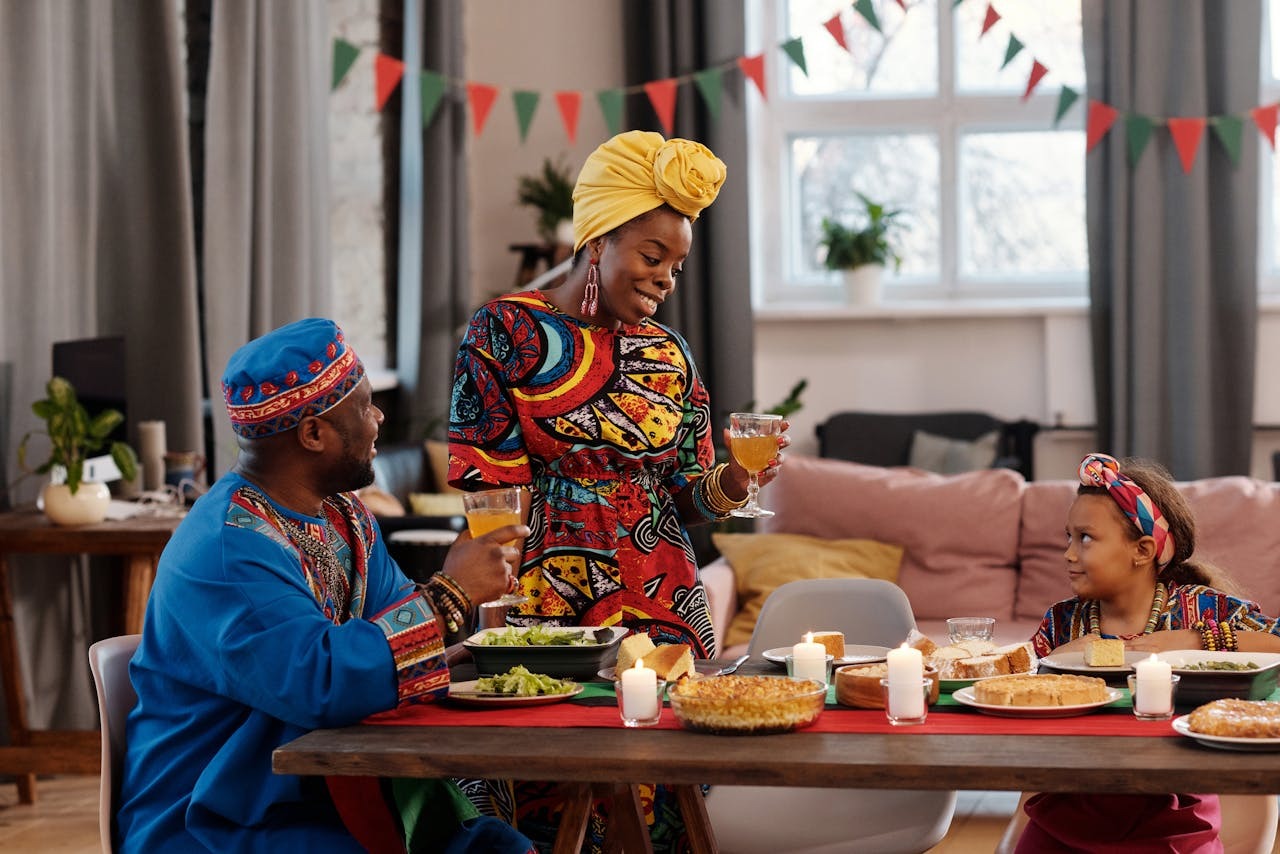
Headwraps offer versatility that extends beyond cultural ceremonies into daily fashion choices. These fabric accessories can transform simple outfits, express personal style, and provide practical benefits throughout various activities and occasions.
Pairing With Outfits
Headwraps complement a range of clothing styles, from casual to formal wear. For everyday casual looks, pair a solid-coloured headwrap with patterned clothing, or choose a bold print headwrap to enliven simple outfits.
When selecting colours, consider your outfit's palette. A headwrap that picks up one accent colour from your clothing creates visual harmony. Alternatively, contrasting colours can make a striking statement.
For workwear, opt for structured wrap styles in subtle patterns or solid neutrals. A neatly tied turban or front knot looks professional with tailored clothing.
Quick Style Formulas:
- Jeans + white t-shirt + patterned headwrap
- Sundress + coordinating solid headwrap
- Monochrome outfit + bright accent headwrap
- Formal wear + silk or satin wrap in complementary tones
Day-To-Night Styling Tips
Transforming headwraps from daytime to evening wear relies on fabric choice and styling techniques. For daytime, cotton and linen wraps offer breathability and casual appeal.
When transitioning to evening events, swap cotton wraps for those with metallic threads, silk, or embellishments. These luxurious fabrics catch light beautifully and elevate your entire look.
Consider adjusting the style as well. A simple daytime wrap can become evening-appropriate when restyled into a more elaborate turban or crown wrap.
Evening Elevation Ideas:
- Add a brooch or decorative pin to your wrap
- Layer multiple wraps for textural interest
- Switch to jewel tones or darker colours
- Incorporate headwraps with subtle sequins or beading
For special occasions, match your headwrap to your accessories rather than your outfit for a sophisticated approach.
Maintaining And Caring For Headwraps
Proper care extends the life of headwraps and preserves their appearance. Wash cotton and synthetic wraps in cool water with mild detergent, either by hand or on a gentle machine cycle.
Silk and delicate fabrics require handwashing or dry cleaning. Always check the fabric care label before washing. Avoid wringing headwraps, as this can distort their shape.
Allow wraps to air dry flat or hung, away from direct sunlight which may fade colours. Iron on low heat if needed, testing on an inconspicuous area first.
Storage Tips:
- Roll rather than fold to prevent creases
- Store in drawers or boxes away from dust
- Group by colour or fabric type for easy selection
- Keep special occasion wraps in cloth bags
Investing in proper storage prevents tangling and damage between wears, ensuring your collection remains ready for styling at a moment's notice.
Respectful Wear And Cultural Appreciation
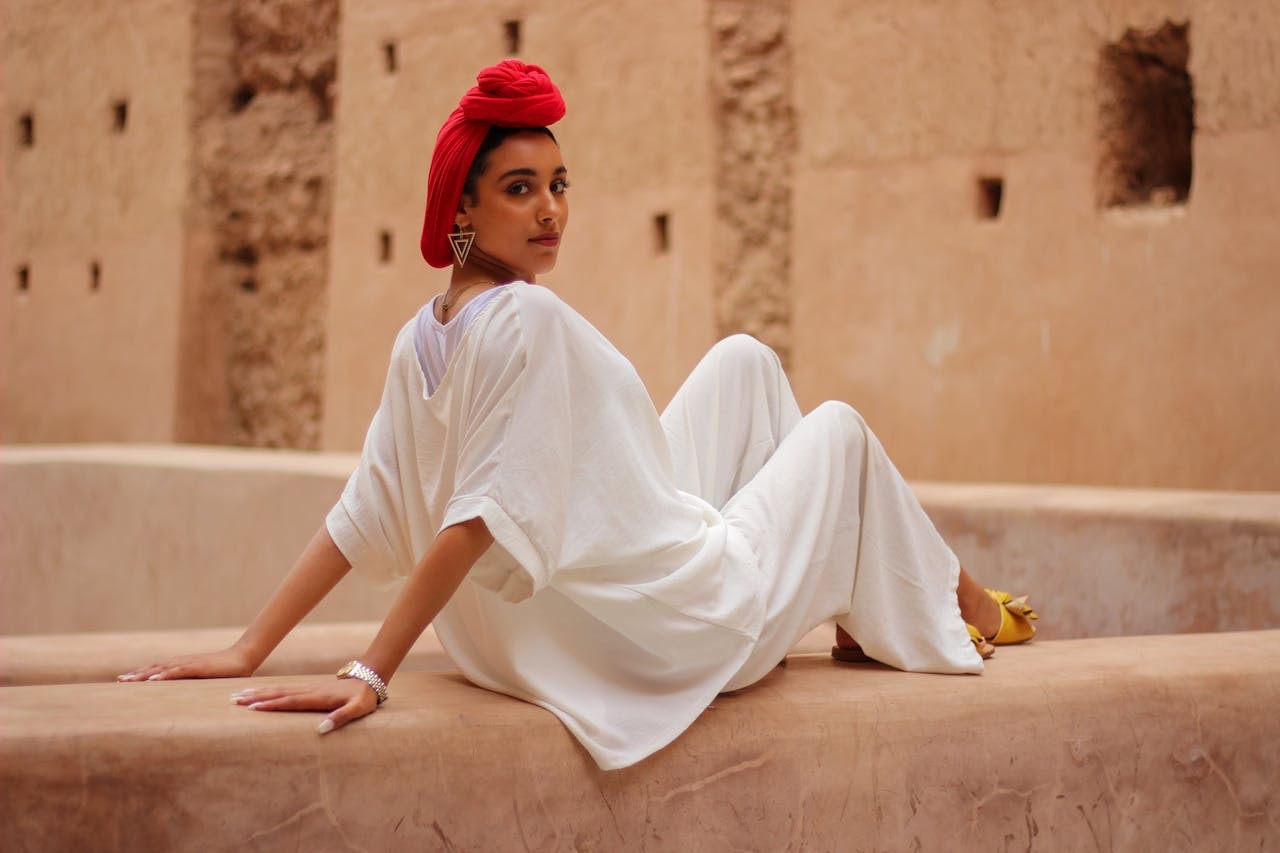
When wearing headwraps from cultures not your own, understanding their significance and approaching them with respect is essential. Proper knowledge helps distinguish between appreciation and appropriation.
Understanding Cultural Contexts
Headwraps hold deep meaning in many cultures around the world. In West African traditions, different wrapping styles can indicate a person's marital status, wealth, or religious affiliation. The gele in Nigerian culture often represents celebration and special occasions.
In Caribbean cultures, headwraps (or tignons) emerged partly as a response to oppressive laws during colonisation. These wraps later became symbols of resistance and cultural pride.
Jewish, Sikh, and Muslim communities also have significant head covering practices tied to religious observance. The tichel, turban, and hijab respectively represent modesty, devotion, and cultural identity.
Before wearing a headwrap, research its significance in the originating culture. This knowledge demonstrates respect and prevents unintentional offence.
Avoiding Cultural Appropriation
Cultural appropriation occurs when elements from a marginalised culture are adopted by members of a dominant culture without proper understanding or respect. With headwraps, this boundary requires careful navigation.
Respectful approaches include:
- Acknowledging the origins of the style you're wearing
- Learning about its cultural significance
- Supporting businesses owned by people from that culture
- Being open to feedback if someone expresses concerns
Avoid:
- Wearing religious or ceremonial styles without understanding their meaning
- Using headwraps as costumes or fashion statements while ignoring their cultural importance
- Renaming traditional styles as "new trends" without crediting their origins
It's perfectly acceptable to appreciate and wear headwraps. The key difference lies in approach—wear them with knowledge, respect, and proper attribution rather than as merely fashionable accessories.
Conclusion
Headwraps remain a powerful symbol of cultural identity, heritage and self-expression across many communities worldwide. They connect wearers to their roots while allowing for personal style and creativity.
Learning to wear headwraps respectfully requires understanding their cultural significance. This knowledge helps avoid cultural appropriation and honours the deep meaning these fabrics hold for many people.
With practice, anyone can master basic wrapping techniques. Starting with simple styles and gradually trying more complex ones builds confidence and skill.
The versatility of headwraps makes them suitable for various occasions. From casual everyday wear to formal events, headwraps can complement any outfit whilst making a statement.
Beyond fashion, headwraps serve practical purposes. They protect hair from environmental damage, maintain moisture and provide coverage during hair growth phases.
The resurgence of headwraps in contemporary fashion highlights their timeless appeal. As more people embrace cultural diversity, headwraps continue to gain recognition globally.
By wearing headwraps mindfully and appreciating their rich history, we participate in preserving important cultural traditions. This celebration of diversity enriches our shared human experience and fosters greater cross-cultural understanding.

